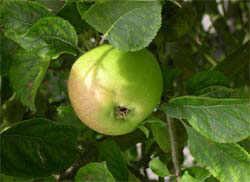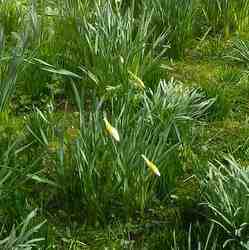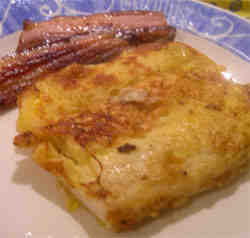Old Fashioned Apple Jelly Recipe
Posted by Fiona Nevile in Jam Jelly and Preserves | 106 comments
A green cooking apple
We always use cooking apples for apple jelly so that it is not too sweet and much more adaptable. For years I only thought of jelly as an accompaniment to meat. The jars opened and enjoyed but usually lost in the depths of the fridge. I cringe now at the thought of the great jellies that must have been wasted on us.
Over the past couple of years we have begun to discover the breadth of the jelly repertoire. Initially, we worked hard trying to make jelly with a good flavour, rather than the ultra sweet stuff that I remember as a child. I asked all my clients for tips. Armed with this unique knowledge, (most of them are good, inventive cooks) and a lot of experimentation we have finally made a small range of jellies that we think are good. This delicate apple jelly is one of the stars.
As we had all these pots of jelly crowding out the larder we were forced to become adventurous. We found that a decent dollop of a stronger jelly in a stew lifted the flavours. We ate it with cheese. We used it in casseroles, as a sauce base for pork and chicken and stirred it into hearty winter soup. We even tried in stir fries (great with a chicken or duck.
We found that dark meat and game cry out for a slightly stronger jelly, such as our damson or wild plum. We also make a punchy sloe and Bramley jelly which adds an extra fillip to a pheasant or venison dish. If we run out of the more raunchy jelly, Danny adds a slug of sloe gin, although I prefer the sharper fruity effect of damson gin. A dash of sloe or damson gin is super in stews, sauces and gravy. You can’t taste the alcohol, just a deep, mellow flavour.
Old Fashioned Apple Jelly Recipe
Ingredients:
- 4 pounds/1.8 kilos of cooking apples (windfalls are fine for this recipe)
- 2 UK pints/1140ml/5 cups of water
- Grated rind and juice of one large lemon
- White granulated sugar (the amount depends on the volume of juice extracted from the simmered, drained fruit. 1 pint/500ml/2 1/2 cups of juice to 1 pound/454gms of sugar. I always make sure that I have a 2 kilo bag of sugar in the larder, just in case I fancy making jelly)
Method:
- Wash the apples, cut out bad bits and chop roughly. There is no need to peel and core the apples.
- Carefully grate the lemon zest from the lemon (we use a zester but a fine grater will do. Try to avoid including the pith as this would make the jelly bitter).
- Place fruit and lemon zest in a large deep heavy bottomed saucepan, or preserving pan. Add the water and bring gently Bring gently to the boil and simmer very gently until all the fruit is soft and mushy (roughly 25 minutes, depending upon how ripe the fruit is).
- Pour the cooked fruit through sterilised muslin. (How do I sterilise muslin? See tips and tricks below). The muslin is often referred to as a “jelly bag”. We use tall buckets to catch the drips from the jelly bags. Rather than hang the bags (conventional method-between two stools) I find it easier to line a large plastic sieve with the muslin. This clips neatly onto the top of a clean bucket. The sieve is covered with a clean tea cloth to protect against flies, as the jelly bag generally drips overnight.
- Measure the apple juice the next day and pour it into a deep heavy bottomed saucepan. Add 454g/1 pound of white granulated sugar for each 570ml/1 pint/2 1/2 cups of juice.
- Add the juice of the lemon.
- Heat the juice and sugar gently, stirring from time to time. Make sure that that all the sugar has dissolved before bringing the liquid slowly to the boil. Continue to boil for about five minutes before testing for a set. (What is testing for a set? See tips and tricks below).
- Toss in a nugget of butter towards the end to reduce the frothing that often occurs.
- When jelly has reached setting point pour into warm sterilised jars using a funnel and ladle. (How do I sterilise jars? See tips and tricks below).
- Cover immediately with plastic lined screw top lids or cellophane tops secured with a rubber band.
Label when cold and store in a cool, dark place. Away from damp. (My jelly is too liquid. See Tricks and tips below)
Tips and tricks:
- What is a jelly bag?
A jelly bag is traditionally a piece of muslin but it can be cheesecloth, an old thin tea cloth or even a pillowcase. The piece needs to be about 18″ square. When your fruit is cooked and ready to be put in the jelly bag, lay your cloth over a large bowl. Pour the fruit into the centre of the cloth and tie the four corners together so that they can be slung on a stick to drip over the bowl. Traditionally a stool is turned upside down, the stick is rested on the wood between the legs and the jelly bag hangs over the bowl. We experimented and now line a sieve with muslin, place it over a bucket and cover the lot with clean tea cloths (against the flies). - How do I sterilise muslin/the jelly bag?
Iron the clean jelly bag with a hot iron. This also works with tea cloths. - What is Jam “set” or “setting point”?
Getting the right set can be tricky. I have tried using a jam thermometer but find it easier to use the following method. Before you start to make the jam, put a couple of plates in the fridge so that the warm jam can be drizzled onto a cold plate (when we make jam we often forget to return the plate to the fridge between tests, using two plates means that you have a spare cold plate). Return the plate to the fridge to cool for approx two minutes. It has set when you run your finger through it and leave a crinkly track mark. If after two minutes the cooled jam is too liquid, continue to boil the jam, testing it every few minutes until you have the right set. The jam is far more delicious if it is slightly runny. - How do I sterilise jam jars?
We collect jars all year round for our jelly, chutney and jam making sessions. I try to soak off labels and store the clean jars and metal plastic coated screw-top lids in an accessible place. The sterilising method that we used is simple. Just before making the jam, I quickly wash and rinse the jars and place them upside down in a cold oven. Set the temperature to 160c (140c fan-assisted). When the oven has reached the right temperature I turn off the heat. The jars will stay warm for quite a while. I only use plastic lined lids for preserves as the all-metal lids can go rusty. I boil these for five minutes in water to sterilise them. If I use Le Parfait jars, I do the same with the rubber rings.
Leave a reply







Can you please give a guide to the amount of jelly to expect from the ingredients listed. I know it will vary a bit, but an approximation would be very helpful.
Hello, Have just made my apple jelly before the frost got to my apples.It has turned out rather well . Can’t wait to taste it tomorrow. However My husband is allergic to all dairy products and now has a sad face due to the knob of butter I added at the end. So is there anything else I can use to remove the froth? Thanks again for this wonderful recipe, I hope to impress my family with it this Christmas 🙂
Help. This is the 1st time I have made jelly. I cannot get the jelly to set. I have followed your guidelines by putting a sample in the fridge and leaving the pot to boil a little longer but it still won’t set. Can you help please.
Hi Rachel
The process of boiling the jelly gradually removes enough water to allow the jelly to set. If there is too much water in the mix, this can take some time. So you just have to be patient. However, there is something that you can do to speed up the process – if you add a tablespoon or two of fresh, sieved lemon juice (this contains a lot of pectin) it will help the jelly to set more quickly.
Good luck!
I have just made my first batch! I cant wait for it to cool ,(Although I did sneak some while checking for a set- yum!!) I haven’t had apple jelly since I was a wee girl! I used to eat it at my Granny’s house. I am super excited by the three jars sitting on my dresser!!
Thankyou!! X
Just made apple and mint jelly with this recipe with the eating apples from our tree – added some extra lemon juice and a bit of white wine vinegar like Liz above so it wouldn’t be too sweet. Jelly now cooling but I’ve tasted a bit and it’s lovely.
I’ve now made apple chutney, apple and blackberry jam, apple jelly, and frozen several bags of puree, and I still have two boxes of apples to use up! Very grateful for this site and your recipes.
Hi
I will be trying your apple receipe but want to ask what to use instead of lemons (and how much) as I have an allergy to them (extremely frustrating!). any help or comments would be appreciated. I have tried using limes but sometimes it creates a weird flavour!
Regards
Caz
two glut crops – apples and chilli – inspire me want to try and make flavoured apple jelly. can i use fresh chilli in apple jelly and if so, any suggestions on the ratio apple to chilli? the other recipes i’ve found use dried chilli flakes.
thanks
Thank you so much for this apple jelly recipe. By the looks of it I have succeeded with my first 2 kilos and will continue with the rest of my apple tree tomorrow.
Thanks again for posting you tips 🙂
Thank you, that’s a really clear, easy recipe! I’m glad I found your site. =)
Greetings from West Coast Canada,
We just moved to a lovily farm and I decided to designate one cupboard for canning supplies. Darling hubby was confused as I’ve never preserved in the seven yrs we’ve been together. Yesterday we harvested dreadfully aweful apples and I started this recipe. Today I have three jars of jelly, three of apple sauce and a sugar headache from liking the froth spoon (never again!) Thank you for all the tips, and for the plain jane recipe. I think I need a bigger cupboard!